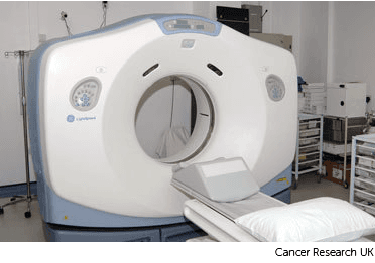Externa beam radiotherapy for prostate cancer
The radiotherapy team plan your external radiotherapy before you start treatment. This means working out the dose of radiotherapy you need and exactly where you need it.
Your planning appointment takes from 15 minutes to 2 hours.
You usually have a planning CT scan in the radiotherapy department.
The scan shows the cancer and the area around it. You might have other types of scans such as an MRI to help your treatment team plan your radiotherapy. The plan they create is just for you.
Before you have your planning scan, your nurse or radiographer ask you to sign a consent form.
Before the scan, you might need to empty your bowels and fill your bladder. Having an empty bowel and a comfortably full bladder can help to reduce the movement of the prostate. And it can lower the dose of radiation to nearby healthy tissues. To do this your radiographers might ask you to use an and tell you to drink a certain amount of water.
Your radiographers will tell you whether you need to do this.
The scan
You lie on the scanner couch. You usually have to remove your trousers before you get on the couch. Your radiographers need to see the treatment area. So they usually ask you to lower your underwear. But they keep you covered up.

The radiographers put some markers that show up on the scan on your skin.
Once you are in position the radiographers move the couch up and through the scanner. You need to lie very still. Your radiographers leave the room and the scan starts. It takes about 5 minutes. You won't feel anything. The radiographers watch from the room next door.
Your doctor might put small metal markers into your prostate gland. These are called fiducial markers.
To place the markers, your doctor inserts a needle into the prostate. They do this while you have an during an outpatient appointment. Once the tip of the needle is in the right place your doctor releases the metal marker. The markers are about 2 to 3 millimetres. You might have some antibiotics before or following this procedure. This is to lower the chance of an infection.
Fiducial markers are one way of making sure that your treatment is accurate. The metal shows the position of your prostate. Your radiographers take images (x-rays or scans) before each of your treatments. They match the position of your fiducials. This should mean your prostate is in the same position for treatment as it was during your planning scan.
The radiographers make pin point sized tattoo marks on your skin. They use these marks to line you up into the same position every day. The tattoos make sure they treat exactly the same area for all of your treatments. They may also draw marks around the tattoos with a permanent ink pen, so that they are clear to see when the lights are low.

The radiotherapy staff tell you how to look after the markings. The pen marks might start to rub off in time, but the tattoos won’t. Tell your radiographer if that happens. Don't try to redraw them yourself.
It can take around 2 to 3 weeks before you start treatment. During this time the physicists and your radiotherapy doctor create your radiotherapy plan. They make sure that the area of the cancer will receive a high dose and surrounding areas receive a low dose.
Find out what happens during your radiotherapy treatment sessions
Last reviewed: 25 Jun 2025
Next review due: 25 Jun 2028
You have external radiotherapy for prostate cancer in a hospital radiotherapy department. You usually have it as an outpatient each weekday over 2 to 8 weeks.
Radiotherapy to the prostate can cause some side effects. These include loose or watery poo (diarrhoea) and problems passing urine.
You might have a type of internal radiotherapy called brachytherapy for prostate cancer. This means that you have a radioactive source inside the prostate.
You may have a choice of treatments such as surgery or radiotherapy. Or your doctor might suggest that they monitor your cancer instead of treatment straight away.
Get practical and emotional support to help you cope with a diagnosis of prostate cancer, and life during and after treatment.
Prostate cancer is cancer that starts in the prostate gland. The prostate gland is found at the base of the bladder and is about the size of a walnut.

About Cancer generously supported by Dangoor Education since 2010. Learn more about Dangoor Education
What to ask your doctor about clinical trials.
Meet and chat to other cancer people affected by cancer.
Questions about cancer? Call freephone 0808 800 40 40 from 9 to 5 - Monday to Friday. Alternatively, you can email us.